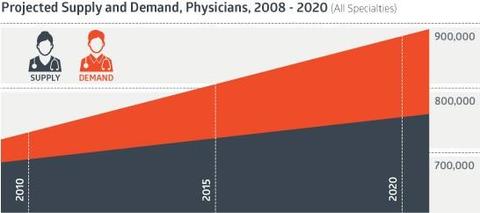Hospitals and health systems need next-generation healthcare services to keep up with the growing U.S. population and increasing number of aging Americans.
While the patient population continues to expand, the healthcare provider community is shrinking. The Association of American Medical Colleges reports that the U.S. will face a shortage of between 40,800 and 104,900 physicians by 2030, and that the number of new primary care physicians and other medical specialists entering the field is not keeping pace with the demands of a growing and aging population.
As the shortage of physicians grows more acute, the need for new forms of care delivery is increasing. Telemedicine will become even more prevalent, with some experts predicting that virtual visits will soon outpace in-person visits. Telemedicine technology has improved in recent years, with a new generation of enterprise-level platforms that are enabling hospitals and healthcare systems to scale and extend virtual services to multiple service lines to manage the digital health care continuum-essentially creating a digital exam room.
These digital exam rooms are allowing for improved treatment adherence and are cutting patient wait time. They represent a form of "consumerism" in healthcare, by which health systems can meet the patient demand for quick and easy access to their providers for non-critical visits. An on-demand approach to healthcare is not just beneficial to the patient; it also cuts down emergency department visits and wait times as patients can seek appropriate advice from their trusted physician before heading to the ER.
Digital exam rooms can be especially helpful in the treatment of chronic disease, which affects many aging Americans. According to the Centers for Disease Control and Prevention, chronic diseases and conditions such as heart disease, stroke, cancer, type 2 diabetes, obesity and arthritis are among the most common, costly and preventable of all health problems. Additionally, about half of all adults in the U.S.--117 million people--have one or more chronic health conditions.
Digital exam rooms are now extending healthcare providers' reach of care to check in on patients at home and follow up on chronic conditions. These telemedicine interventions are vital for monitoring overall health before any serious health concerns develop. Not only is this cutting patient hospital admissions and re-admissions, it's improving overall patient wellness and cutting costs.
[...]
White-label versions can even leverage a patient's trusted provider or health systems branding during every virtual exchange. Furthermore, providers should prioritize cloud-based functionality to safely and securely store all personal health information with the highest levels of HIPAA and HITECH compliance. Patients also benefit from convenient access to care from the comfort of their own home, reduced costs, and the ability to better manage and treat illnesses or chronic conditions.
By making telehealth a provider and patient priority, hospitals and health systems can remain competitive in the fast-paced world of healthcare, and help address the needs of a growing patient population more effectively.
Source: Becker's Hospital Review (View full article)
Posted by Dan Corcoran on December 5, 2017 07:27 AM



Post a comment